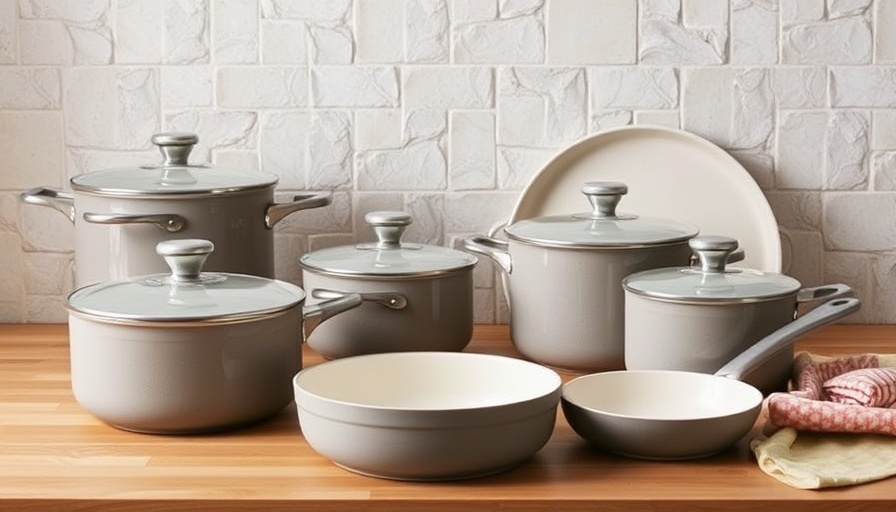
Beyond the Hype: Understanding the New Wave of Cookware
The cookware market is buzzing, largely due to the rise of so-called "nontoxic" and "nonstick" ceramic pans embraced by influencers and celebrities alike. Thriving brands like Always Pan and Caraway present an alluring image of health and safety, drawing in consumers eager to invest in healthier kitchen tools. However, amidst the glitzy advertisements and vibrant Instagram posts lies a more complex story touching on authenticity, transparency, and safety.
Are 'Nontoxic' Cookware Claims Too Good to Be True?
The term "nontoxic" is often tossed around without proper regulation or a clear definition. As it stands, there is no legal standard defining what exactly constitutes "nontoxic" or even "ceramic," which opens the door to misleading claims. A growing body of independent research suggests the trendy quasi-ceramic pots may harbor harmful toxins, such as titanium dioxide, siloxanes, and even heavy metals like lead and mercury. It's a cautionary tale reminding us to scrutinize the promises made by brands that leverage health and wellness narratives for consumer appeal.
Marketing Magic: The Power of Social Media Influence
Social media platforms have played a significant role in elevating cookware brands into household names. Marketing campaigns touting enchanting product designs have capitalized on the surge of wellness culture during the pandemic, leading eager home cooks to click the “buy” button during lockdowns. Caraway, for instance, saw a jaw-dropping 390% increase in ecommerce sales from January to May 2020—an eye-opening statistic that underscores how dynamic market forces can shift consumer behavior towards specific health-oriented products.
Regulatory Scrutiny: A Growing Call for Transparency
In light of these revelations, regulatory bodies are taking a closer look at the cookware industry. Washington's state authorities recently mandated that producers of quasi-ceramics disclose their nonstick ingredients to promote transparency in what families are buying. Marissa Smith, a senior toxicologist at the Washington Department of Ecology, describes the challenge consumers face when navigating this murky territory: “It’s challenging for regulators to know when we’re moving to safe alternatives, but it’s also hard for families who want to buy safer products.” This statement resonates deeply with a growing number of consumers advocating for clarity on what materials they use daily, especially concerning their health.
What This Means for Your Health and Wellness
As consumers, understanding the implications of cookware choices is crucial in our journey toward optimal health and wellness. Prior to the adoption of quasi-ceramic alternatives, many nonstick pans were known to contain toxic per- and polyfluoroalkyl substances (PFAS)—substances linked to significant health risks, including certain cancers. Although new products appear safer at first glance, hidden dangers may still linger. For anyone engaged in health-conscious living, this reality only emphasizes the importance of being informed, not just about food choices, but also about the tools used to prepare meals.
Practical Insights: Making Mindful Cookware Choices
When it comes to selecting cookware, vigilance is key. Armed with information, consumers can seek reputable brands that prioritize transparency in their marketing and disclose a full list of materials used in production. Additionally, reviewing third-party testing results and steering clear of ambiguous terms like "nontoxic" can help ensure that your kitchen tools align with your wellness ethos. If you find yourself drawn to the aesthetic appeal of a product, take a moment to research its safety practices and materials.
Conclusion: The Journey Towards Healthier Living
The allure of new cookware innovations may draw us in, but it's the substantive understanding of these products that enables us to make informed decisions for our health and wellness. As we navigate the marketplace filled with shiny promises, let us prioritize transparency and genuine safety in every aspect of our cooking experiences. The journey towards healthier living is ongoing—and it starts at home, in the very pots and pans we select to nourish ourselves and our families.
In light of the ongoing discourse about healthier lifestyles and product safety, this article aims to encourage you to be proactive in your choices. Consider attending local health and wellness events to connect with experts in the field to stay informed on the best practices and trends in healthy living.
 Add Row
Add Row  Add
Add 




 Add Row
Add Row  Add
Add 


Write A Comment